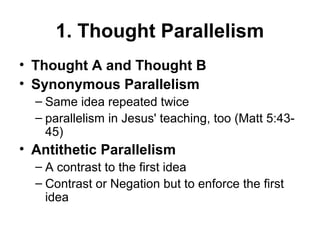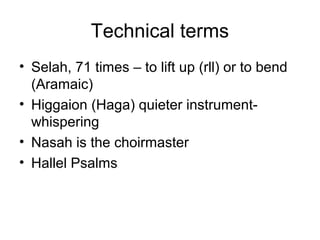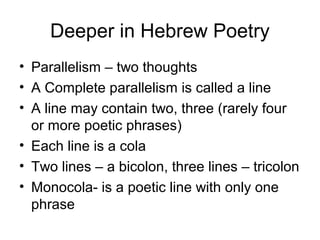Experiencing the Psalms
- 2. What Is a Psalm? âĒ GreekĖýpsalmosĖý âĒ HebrewĖýnounĖýmizmÃīr,Ėý"song,ĖýinstrumentalĖý musicâĖý âĒ verbĖýzÄmar,Ėý"sing,ĖýsingĖýpraise,ĖýmakeĖý musicâ.Ėý âĒ heĖýBookĖýofĖýPsalmsĖýwasĖý--ĖýandĖýisĖý--Ėý intendedĖýforĖýsingingĖý âĒ theĖýchurch'sĖýfirstĖýsongĖýbookĖý
- 3. WhatĖýisĖýfoundĖýinĖýpsalms? âĒ expressĖýtheĖýentireĖýspectrumĖýofĖýhumanĖý emotionĖý--Ėýfear,Ėýdespair,Ėýlonging,Ėýlove,Ėý hope,Ėýjoy,ĖýandĖýexultationĖý âĒ MadeĖýofĖýprayersĖýandĖýpraiseĖýtoĖýGod âĒ Poems âĒ Songs âĒ PetitionsĖý
- 4. PsalmsĖýâĖýHebrewĖýPoetry âĒ HebrewĖýpoetryĖýdiffersĖýfromĖýmostĖýWesternĖýpoetryĖý âĒ ItĖýdoesnâtĖýrhyme âĒ twoĖýprimaryĖýelementsĖý âĒ Thought parallelism âĒ ImageryĖý âĒ westernĖýpoetryĖýweĖýuseĖýbothĖýrhymeĖýandĖýrhythmĖý âĒ HebrewĖýpoetryĖýtheĖýrhythmĖýmayĖýbeĖýinĖýtermsĖýofĖý unitsĖýperĖýlineĖý
- 5. 1. Thought Parallelism âĒ Thought A and Thought B âĒ Synonymous ParallelismĖý â SameĖýideaĖýrepeatedĖýtwice â parallelismĖýinĖýJesus'Ėýteaching,ĖýtooĖý(MattĖý5:43- 45) âĒ Antithetic ParallelismĖý â AĖýcontrastĖýtoĖýtheĖýfirstĖýidea â ContrastĖýorĖýNegationĖýbutĖýtoĖýenforceĖýtheĖýfirstĖý idea
- 6. 2. Imagery âĒ ImageryĖýhasĖýaĖýwayĖýofĖýfixingĖýanĖýideaĖýinĖýourĖý mindsĖýwithĖýclarityĖý âĒ ThereĖýareĖýtwoĖýkindsĖýofĖýimagesĖý âĒ 1.ĖýSimileĖýisĖýaĖýcomparisonĖýwhichĖýisĖýmadeĖý explicitĖýbyĖýtheĖýpresenceĖýofĖýtheĖýwordĖý"like"Ėý orĖý"as."ĖýĖýPsĖý42:1 âĒ 2.ĖýMetaphorĖýisĖýaĖýcomparisonĖýthatĖýisĖý implicit,ĖýthatĖýis,ĖýaĖýcomparisonĖýwithoutĖýtheĖý mentionĖýofĖý"like"ĖýorĖý"as."ĖýPsĖý23:1Ėý
- 7. Categories of Psalms âĒ The Hymn, âĒ The Lament âĒ Thanksgiving Psalms âĒ Psalms of Confidence âĒ Psalms of Remembrance âĒ Wisdom Psalms âĒ Kingship Psalms
- 8. Authors of Psalms âĒ 150 psalms âĒ 116 include an extended title or an ascription that is part of verse 1 in the Hebrew text âĒ Added by editors very early âĒ The titles at the beginning of many of the psalms âĒ carry the ideas "of, for, from, at, in reference to, belonging to.
- 9. Homework âĒ Psalm 34, 55, 85, 95, 135, and 40. read and Identify the genre. âĒ Identify the genre of Psalms 40 and 54. State why you get that from their structure.
- 10. Authors âĒ David Named as author of nearly half the collection âĒ Asaph Called "Asaph the Seer" (2 Chronicles 29:30), and was from a Levitical family. He founded the temple choir as chief musician (1 Chronicles 15;17-19; chapter 16). âĒ =73 psalms âĒ Psalms 50, 73- 83 =12 psalms
- 11. Authors âĒ Sons of Korah A Levitical family, singers and musicians of the temple choir founded by Heman the Ezrahite (1 Chronicles 6:31-46). âĒ Ethan the Ezrahite = Juduthun From a Levitical family and founded one of the temple choirs (1 Chronicles 16:41; 25:1-6). âĒ Psalms 42-49, 84-85, 87- 88= 12 Psalms âĒ Psalm 89, 39, 62, 77= 4 Psalms
- 12. Authors âĒ Heman the Ezrahite Called "Heman the Musician" (1 Chronicles 6:33) and was founder of a temple choir. âĒ Solomon Third king of Israel âĒ Moses Leader during the Exodus âĒ No title at all âĒ Psalm 88= 1Psalm âĒ Psalms 72, 127= 2Psalms âĒ Psalm 90= 1Psalm âĒ 34 Psalms
- 13. Origin and title âĒ The Title âĒ The title may give info about the author, the historical occasion, the functionâĶ âĒ A Psalm without an author is generally called an âOrphan Psalmâ (ex. Psalm 33) âĒ Many psalms gave a historical title ex. Psalm 3 âĒ 14 of them/ Ps. 3, 7, 18, 30, 34, 51, 52, 54, 56, 57, 59, 60, 63, 142.
- 14. Groupings âĒ The Psalms are divided into 5 groups âĒ Psalm 1- 41 Group 1 âĒ Psalm 42-72 Group 2 âĒ Psalm 73-89 Group 3 âĒ Psalm 90-106 Group 4 âĒ Psalm 107-150 Group 5 âĒ The Book of Psalms is called in Hebrew: Tehillim which means âsongs of praiseâ
- 15. Technical terms âĒ Selah, 71 times â to lift up (rll) or to bend (Aramaic) âĒ Higgaion (Haga) quieter instrument- whispering âĒ Nasah is the choirmaster âĒ Hallel Psalms
- 16. Deeper in Hebrew Poetry âĒ Parallelism â two thoughts âĒ A Complete parallelism is called a line âĒ A line may contain two, three (rarely four or more poetic phrases) âĒ Each line is a cola âĒ Two lines â a bicolon, three lines â tricolon âĒ Monocola- is a poetic line with only one phrase
- 17. MoreâĶ. âĒ Elipsis in parallelism âĒ It is to bind the two phrases more closely together âĒ Inclusio- A line that opens a closes a poem âĒ Acrostic poems âĒ The Hebrew Alphabet âĒ Acrostic psalms: 9, 10, 25, 34, 37, 111, 112, 119, 145
- 18. Imagery âĒ Simile and metaphor âĒ Imagery is the fact that a picture is formed in oneâs mind by reading the psalm âĒ On many instances like a personification âĒ Images are not as precise as literal language/ but both are correct when you understand the context and the meaning of the image âĒ Ex. The ennemy is a lion The ennemy is ruthless and cruel
- 19. Incomprehensibility of God âĒ Why so many images in the Psalms? The answer lies in Godâs own nature. Images, simile and metaphors help to communicate the fact that God is so great and powerful and mighty that He canât be exhaustively described. Images, may be accurate but less precise that literal language. Images preserve the mystery of Godâs nature and being, while communicating to us about Him and His love for us
- 20. Homework due February 7 âĒ Psalm 47. Do you find any ellipsis? identify âĒ Psalm 2 â Read â identify the separate poetic lines. â Identify the phrases within the lines and identify them as mono, bi or tri cola (colon) âĒ Identify the metaphors in Psalms 80 and 129 âĒ Read Psalm 124. The great image in this poem is water, â Meditate on this image and â show how water illuminates the depths of the authorâs suffering âĒ Read Psalms 30 and 35. â List all the great images on God. â Write how great, mighty and loving God is according to these psalms Due Tuesday either by email (or in person)/ or as you enter class â Please cover page and indentify the questions as youâre answering them. Thank you!
- 21. CLASS EXERCISE âĒ Psalm 46 â Different lines (mono, bi, tri cola [colon]) âĒ Similes in Psalms 52, 83





















![CLASS EXERCISE
âĒ Psalm 46
â Different lines (mono, bi, tri cola [colon])
âĒ Similes in Psalms 52, 83](https://image.slidesharecdn.com/experiencing-1-1328130166-phpapp01-120201150412-phpapp01/85/Experiencing-the-Psalms-21-320.jpg)






























![Tik Pas Rusus Taip[1][1]..](https://cdn.slidesharecdn.com/ss_thumbnails/tikpasrusustaip11-100114131239-phpapp01-thumbnail.jpg?width=560&fit=bounds)






















